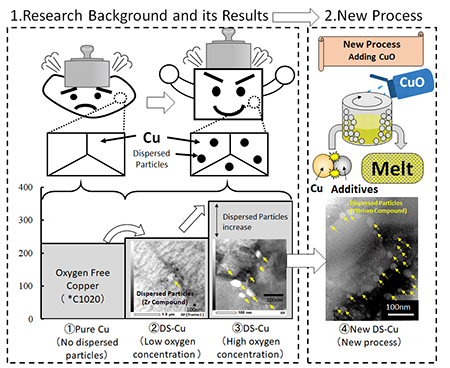HOME > Research Activities > Research Updates >
Developing the Dispersion Strengthening Copper carrying cooling function
Stars of the Universe, such as the sun, shine due to the fusion reaction. Fusion power makes the fusion reaction on the earth and generates electricity by taking out energy from the fusion reaction. To achieve this, the development of instruments that receive energy generated in the fusion reactor is one of the important issues. This time, we introduce development research for new materials which are indispensable for producing such instruments.
Although the Large Helical Device(LHD) confines hot plasma in the magnetic cage, the plasma particles gradually escape outside the cage. The particles are caught with an instrument called the divertor. There, the particle energy is converted into heat. As a result, the surface of the divertor takes a high heat load (amount of heat per unit area). In the future fusion reactor, the heat load to the divertor will grow higher and is expected to reach the same level as the inner wall of the skirt of a rocket engine. Thus, NIFS is promoting development research of the divertor with improved heat removal performance. The divertor removes the heat generated on the plasma-facing part with streaming cool material (transportable material such as water) to piping. For improving the cooling ability of the divertor, it is necessary to efficiently conduct the heat produced on the plasma-facing part to the cooling material. Therefore, thermal conductivity, or the ease of conducting heat, is important as the material for the parts which cool the pipes. Thus, cupper(Cu) is focused upon because it is a metal whose thermal conductivity is good.
Copper is the material for the ten yen Japanese coin. Though a copper pot is expensive, it is said that we can cook well because its thermal conductivity is good. In this way, copper is familiar to us but has the defect of low strength as the material of the cooling parts of the divertor. Therefore, NIFS promotes development research for high strength copper by the method of "Dispersion Strengthening". Dispersion Strengthening is the method for highly strengthening the material with uniform dispersal of different kinds of nano level size particles (dispersed particles) on the material. The metal made this way is called "dispersion strengthened alloy." This method is known as a technique studied in the iron field to date and has succeeded in greatly strengthening (Please refer to back number 257 regarding research in NIFS). However, its applications for copper have not been sufficiently studied.
In general, dispersion strengthened alloy is made by melting metal to put dispersed particles into the metal. Though it was found that dispersion strengthened copper is also made by melting the metal at first, the strength was not sufficient to overlook the performance or demand in the future. Therefore, we adopted the method of placing small particle copper and materials of dispersed particles (zirconium or yttrium) into the case with hard iron balls, to spin the case at high speed, to mill fine powder from them, and to mix them. By hot isostatic pressing of this mixture of the fine powder, we make a lump of the metal without melting. When we confirmed the strength of the test material made this way, it turned out that the test material is much stronger than pure copper. Next, we studied changing "oxygen density" melting in the test material. Generally, the metal melting much oxygen has no good influence, but it turns out that the strength increases as the result of the research to the contrary. And we observed the test material with an electron microscope. If oxygen density is high, it turns out that many finer particles are scattered. By this, it is thought that new dispersed particles are made by combining oxygen with the material of dispersed particles in the test material.
In addition, we made dispersion strengthened copper by introducing an unprecedented new process and succeeded in making the test material. The new process is to add a new additive (copper oxide) to induce making strengthened particles in the middle of milling particle copper and materials of strengthened particles to mix them. In short, this is a method to make dispersion strengthened copper with controlling the amount of the production of strengthened particles. If this method is established, it is expected to greatly contribute to development research of dispersion strengthened alloy. Now, we are promoting examining the strength of this new dispersion strengthened copper. Please expect further advances in our research.

Left image: Comparison of the strength of pure copper and dispersion strengthened copper(DS-Cu). A vertical axis of the lower graph shows strength. Dispersion Strengthened Copper② has higher strength than pure copper①. Dispersion Strengthened Copper③ with high oxygen content achieved higher strength by increasing dispersed particles.
Right image: We introduced a new process of adding copper oxide while mixing the particle copper and the dispersed particles, and succeeded in producing a new dispersion strengthened copper.
